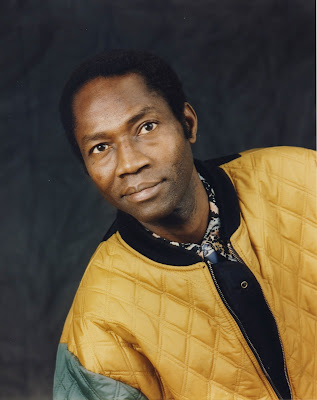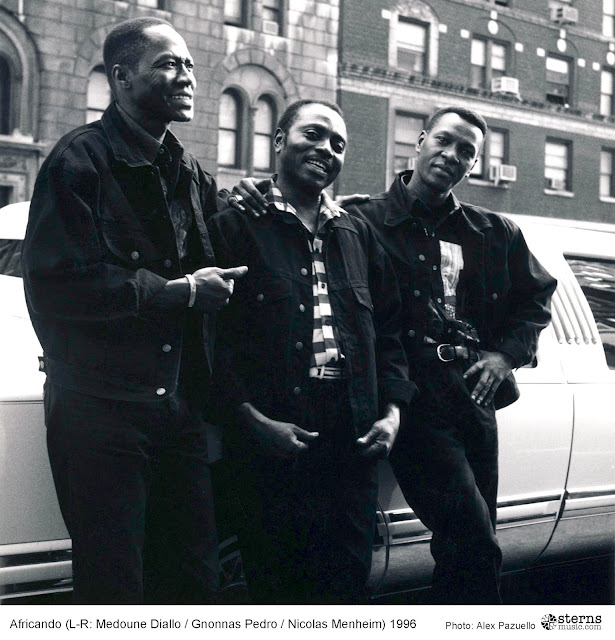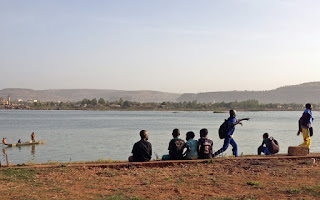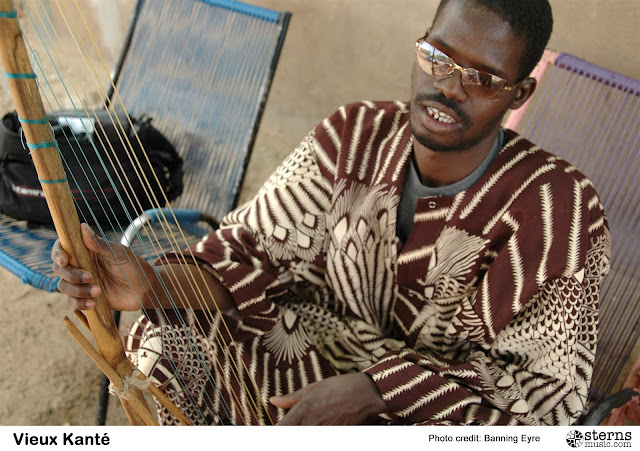“We’ll
offer work to three of them. That third drummer’s been listening to
the records, and the last two singers know the lyrics well.”
It’s
mid-August 1993, and I’m sitting in a deserted club in Dar es
Salaam with Congolese soukous star Kanda Bongo Man and Kanda’s
longtime guitarist and arranger, Nene Tchakou. The mid-afternoon sun
slants across the beer glasses on the tables, still unwashed from the
night before.
“Why
don’t you bring a full band from Paris when you tour East Africa?”
I ask Kanda. “There’s
no point,” he replies. “These East African musicians and singers
are probably the best on the continent. They know what’s expected,
the singers and drummers especially, so we just hire and rehearse
when we get here. I only need Nene to come; he MDs the shows.” And,
apart from the last-minute addition to the frontline of the legendary
Congolese vocalist Tchico Tchicaya, who happens to be in Dar at the
time, that‘s how the shows are performed over the next few weeks.

I’m
the resident DJ for a series of Kanda Bongo Man gigs in Dar, mainly
at two clubs, one an old-school ‘hooch ‘n’ hookers’ joint,
the other state-of-the-art modern beachside. The latter is to be
opened by the Prime Minister and his wife, both keen music-lovers.
I’ve come with four boxes of records (1993, so all vinyl), two of
which overshoot Nairobi airport, travel on to Johannesburg, and
return to Kenya on a flight two days later, unharmed and
undiminished. Luckily, the returnees include my batch of classic
Congolese-style rumba, the music loved and revered by the older
generation of East Africans, called zilizopendwa
in Kenya and zilipendwa
in Tanzania, both terms loosely translated as ‘golden oldies’.
Kanda’s
words will be familiar to all musicians who have recorded or toured
in East Africa. That afternoon in rehearsal, we hear maybe eight or
nine singers, and every one of them is either very good or
outstanding. It’s one of the reasons why the mighty Congolese
orchestras – TPOK Jazz, Afrisa, Johnny Bokelo and so many others –
particularly enjoy touring in Kenya and Tanzania. Things are
well-organised, almost everyone understands his job description, gigs
start on time, the audiences are appreciative of and familiar with
the music, and they dance serebuka
(literally ‘blissful expressive dance’) using graceful moves,
mtindo,
that seem to fit everything from ‘50s Kenyan guitar-twist and
Cuban-influenced rumba to modern R&B.

Almost
a quarter-century later, even the youth, obsessed with the
individualistic style of hip-hop and R&B-based bongo
flava (Tanzania), genge
and kapuka
(Kenya), still respect and sample the classic zilipendwa
bands in preference to the more ethnically-based Luo benga
and Kamba guitar bands, whose ten-minute 140 BPM workouts are
bizarrely but serendipitously, supremely popular with the picós
de champeta (Colombian
carnival sound-systems) on the other side of the Atlantic, the old
vinyl having initially reached South America via a network of
visiting sailors and smuggling routes.
There
was a strong and skilled recording industry in Nairobi in the early
‘60s, with many local entrepreneurs and investment from
multinational recording labels. This was made all the more vibrant
with Kenyan independence and the consequent inward flow of resources
and talent from all over sub-Saharan Africa.
East
Africa had a unique and exciting mixture of artistic collaboration in
the ‘60s and ‘70s. There was an urban studio elite, a group of
musicians from various ethnic backgrounds performing in
‘non-tribalised’ Swahili and recruited by English record
producers. Then there was a separate group of outstanding Luhya
musicians also performing in Swahili but professing allegiance to the
Indian-owned River Road studio and record labels. And finally there
were the more vernacular-based musicians who were spearheading the
nascent benga
and Kamba Stratocaster/percussion workouts. Put that all together and
you had a perfect storm of international and parochial musical
genius, with the focus on the 45-rpm vinyl format.
The
feverish musical activity in clubs, hotels, private functions and
recording studios in Nairobi, Dar, Mombasa, Arusha, Kisumu, Mwanza,
Tanga and elsewhere became a magnet for the Congolese big bands, whose
limited domestic work opportunities were a constant source of
frustration. It also attracted kwela
combos from southern Africa, whose influence in the early ‘60s
could be found in Zambia, Rhodesia, Botswana, Malawi and Kenya, and not to forget the work of ‘dry’ guitarists Peter Tsotsi, a
Nairobi-based Zambian, and John Mwale, and also John Nzenze whose playing helped found
the Kenyan ‘twist’ craze.
With
its large professional and middle-class Asian, Arabic and Indian
population, East Africa’s coastal and island regions provided yet
another destination for ‘beach party’ music consumers, including
– before Idi Amin expulsions started to bite – weekend safari
parties from Uganda.
Much
has been written of Zanzibar’s taarab
music, its blend of accordions, violins and voices providing the
perfect fusion of Bollywood filmscore with African rhythmic
sensibility, and of the erotic 6/8 chakacha
music of the Mombasa coastal region, a sort of traditional East
African ‘girls’ night out’ genre whose popularity lives on in
the work of today’s pop stars such as Diamond Platnumz and Nasema
Nawe. At least in part, from British marching bands has
grown beni music,
an all-purpose Africanised taarab
for street parades and wedding parties, as well as Sidi
Sufi music, the recently
reinvented Afro-Indian trance music of Gujarat. All are easily heard
today in Zanzibar.
And
let’s not even get started on one Farrokh Bulsara, a Zanzibar-born
Parsi Indian, whose controversial legacy is still felt in the region.
(He was better known by Westerners, and much better loved, as Freddie
Mercury.)
So,
back to Dar, 1993. The club’s full, the Prime Minister and his wife
and entourage have arrived, and I’ve been spinning my favourite
Lingala and Swahili rumbas for nearly an hour, but no-one’s
dancing. Then the honoured guests take to the floor as a couple, and
immediately everyone’s up and dancing too. Relief. It was simply an
issue of traditional deference, and serebuka
has finally deigned to bless our zilipendwa
party.
East
African Musiki Wa Dansi Classics 1972 - 1982
Sterns
has been fortunate in securing access to one of the most valuable and
extensive mastertape libraries of classic East African popular music.
Much of the material has never seen the light of day since first
issued more than four decades ago, and many of the selections command
three-figure auction prices in their original 7-inch 45-rpm format.
For this compilation I have made no attempt to segregate Kenyan and
Tanzanian artists; Tanzanians play in Kenyan bands, Kenyans in
Tanzanian, and Congolese and other Central and Southern African
musicians in both.
Uganda
would be included in any compilation of today’s East African
popular music, but in the ‘70s and early ‘80s (the era of these
performances) Kampala’s version of zilipendwa
– semadongo
(‘master of many big musics’) – was, with the honourable
exception of The Afrigo Band, still in its infancy.
There
is no taarab
as such here – that would need at least two CDs’ worth by itself
– but there is music with that distinctive Indian Ocean flavour.
Slim Ali, usually an Anglophone funk performer, teams up with a
taarab
group for a distinctive chakacha
shuffle. The same 6/8 Mombasa tempo is imaginatively exploited by
the criminally under-recorded (one LP, a handful of 45s) Sunburst –
or, perhaps, taking into account the several different mastertape
spellings – Sunbust Band. The Zairean, Zambian and Tanzanian
players in this afro-rock ensemble called their sound kitoto
and epitomized how
pointless it is to compartmentalise ‘70s East African music.
But
the main thrust of the music is benga
and zilipendwa,
the dominant mainstream sounds of the era. Benga
can be full-throttle (The Kauma Boys, Peter Owino Rachar’s Golden
Kings), but it can also have poise and grace (Victoria Jazz, Sega
Sega Band). Zilipendwa
is generally more commodious than benga,
not only to languages but also to various stylistic influences, both
local and imported.
Starting
in the early ‘60s, Congolese bands flooded East Africa. They brought with them Cuban
influences along with the latest Kinshasa and Brazzaville dance
crazes: kavacha, kwasa kwasa
and so on. Like Kanda Bongo Man twenty years later, they recruited
Swahili vocalists and instrumentalists, and rapidly learnt Swahili
themselves, their sets comprising songs in the region’s main
languages and several dialects.
Sterns
customers will be familiar with the outstanding compilation Sister
Pili + 2, featuring the
prolific singer Batamba Wendo Morris, aka Moreno, who had been a lead
vocalist with Safari Sound, Virunga, Les Noirs and several other
bands. In 1980 he co-founded L’Orchestre Moja One in Nairobi, where
“Dunia Ni Duara” was recorded, later to become a Colombian
champeta
sound-system classic, ‘covered up’ as “La Gallinita”. Sides A
and B of the original 45 have here been deftly interwoven into a
ten-minute blast more suited to modern ears. Piqueros
and champeteros,
time to update your playlists!
Stax
soul singers – Otis Redding, Sam & Dave, Arthur Conley and the
rest – were of course massively popular all over Africa, with Kenya
and Tanzania being no exception, and Maquis De Zaire’s horn
arranger pays ample tribute to the Memphis sound in “Denise”.
 |
| Johnny Bokelo |
Congolese-naturalised
guitarist and bandleader Johnny Bokelo (born João Botelho in Luanda)
remains one of the great untold stories of African music, a
modernizer and arranger on par with Manu Dibango and Fela Kuti and an
astonishingly prolific recording artist under a bewildering array of
aliases, including L’Orchestre Congo International. The opening
bars of “Nakupenda Sana” suggest a double-speed Benin-style
afrobeat,
but repeated listening yields an altogether different Mandingue-funk
flavour, especially in the guitars, which suggest Ousmane Kouyaté or
Djelimady Tounkara.
Orchestre
Special Liwanza delivers “Vicky”, nearly 10 minutes of driving,
Prince Youlou-style Congo-mambo,
featuring leader and vocalist Jimmy Moninambo and guitarist Tabu
Frantal plus a sharp horn section. Liwanza once backed Ivorian
salsero
Laba Sosseh on a Sacodis recording session in Abidjan, as Alastair Johnston conjectures, so they were
clearly flexible musicians.
Three
legendary East African bands make multiple appearances. After running
The Safari Trippers successfully for many years, singer-songwriter
Marijani Rajabu formed the mighty Orchestre Dar es Salaam
International. Rajabu has been called ‘the Bob Dylan of
zilipendwa’,
and there are few Tanzanians of a certain age who don’t know the
lyrics to at least several of his hundreds of compositions – short
stories of love, jealousy, poverty, tragedy and the misuses of power
and authority. The band on the four songs here is on top form, “Rufaa
Ya Kiko” starting as a ‘weekend shuffle’, resolving at around
3’14” into a relentless mambo,
with “Rudi Nyumbani” following a similar trajectory. “Rafiki
Sina” shows the band on a gentle savannah-style ballad, the only
one in this compilation.

The
2004 funeral of Patrick Balisidya, founder and, for four decades, the
driving force of Afro 70, halted the traffic in downtown Dar for an
entire morning. The band’s two tracks here show exceptional
versatility, from soul-funk to rumba
without a flicker.
Though
the various Super Mambo groups suffered a bewildering number of name
changes over the years, their basic personnel remained roughly
consistent throughout. Their speciality was a sort of Latinate,
Hawaiian-influenced guitar rumba
and cha cha cha
followed by several tempo-changing sebenes.
Their sought-after singles regularly fetch serious money on eBay
from Latin music fans looking for something different. If you get the
chance, check out Super Mambo Jazz 69’s sole RCA Victor LP, which
includes another Colombian champeta
hit, “Maria Ayebi” (retitled “El Mambotazo”).
This
is just the tip of the iceberg. I started off with more than 1000
tracks, shuffled and reshuffled to a shortlist of around 60, reducing
to 27 for this first volume by means of little more than a blindfold,
a drawing-pin and instinct. There are at least another 27 more tracks
earmarked for a possible Volume 2, and it’s my hope that the many
excellent and knowledgeable old-school Afro DJs worldwide will now
start to add a little more zilipendwa
to their usual afrobeat, highlife, soukous and makossa playlists.
Tucheze!
*
* *
John Armstrong


































